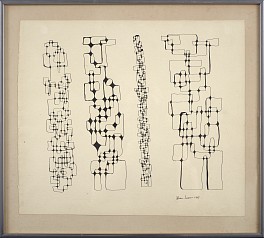BIOGRAPHY

IBRAM LASSAW (1913-2003)
Ibram Lassaw’s parents were Russian, but he spent his childhood in Egypt, where he attended a French lycée. In 1921 he immigrated with his family to New York, where he began his artistic training with traditional clay modelling at the Brooklyn Children’s Museum and in 1927 at the Clay Club. In 1931–2 he attended evening classes at the Beaux-Arts Institute of Design. After modelling clay figures, in 1933 he turned to abstract sculpture, and was among the first American sculptors to do so in the 1930s. Early open-space constructions such as Sculpture in Steel (1938; New York, Whitney) combine biomorphic elements with Constructivist methods. The leaflike elements suspended from a metal bar seem indebted to Alberto Giacometti’s Surrealist sculptures of the 1930s.
Lassaw studied the welded constructions of Julio González and Pablo Picasso, which were illustrated in French periodicals, and he was attracted to their openwork compositions in industrial metals. While Lassaw’s earliest constructions were made of reinforced plaster on pipe and wire armatures, by 1937 he had purchased a powered jigsaw and learnt to braze iron rods to which he fastened carved wooden elements. In 1938 he created several wooden shadow boxes with hidden electric bulbs to illuminate the interiors. These works, which combined objets trouvés, wooden elements and painted metal shapes, were an innovative fusion of biomorphs with László Moholy-Nagy’s ideas for light-space constructions.
Lassaw was employed by the Works Progress Administration’s Federal Art Project from 1935 to 1942. When the American Abstract Artists group formed in 1936, he was a founder-member and exhibited regularly with them. In 1942 he served in the US Army, where he learnt the welding techniques that he used in his sculpture during the following decades. In the 1940s he experimented with acrylic plastics, adding colour by applying dye directly to the surface of the abstract forms. After purchasing equipment for oxyacetylene welding in 1951, he began to combine molten materials coloured with acids and alkalis in an improvisational approach that can be related to the gestural painting of Abstract Expressionism. Kwannon (1952; New York, MOMA) is typical of his mature production. Using metal rods of various alloys, he created a range of colours and textures in a delicate cage-like construction. His intellectual interests were broad-ranging and included the physical sciences and Zen Buddhism. Titles for his works came from mythology, astronomy, and other sciences. He considered his sculptures to be metaphors of universal existence, viewing the universe as a continuum and his works as analogical fragments of both religious and aesthetic significance. In 1959 a bronze construction entitled Presence was installed in Steinberg Hall at Washington University, St Louis, MO. Lassaw was among the few abstract sculptors to be included in the American National Exhibition in Moscow, also in 1959. In his later years he completed several large-scale indoor and outdoor commissions for synagogues, a church, and private residences. Lassaw was included in many group exhibitions of the Abstract Expressionists, but his work was not fully acknowledged as related to this movement.
Joan Marter
